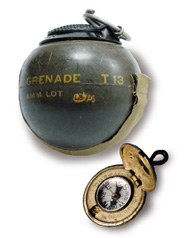This article needs additional citations for verification. (April 2021) |
The BEANO T-13 hand grenade was an experimental grenade developed by the Office of Strategic Services (which later became the CIA), with assistance from Eastman Kodak Corporation, in the later years of World War II.[2]
| BEANO T-13 Hand grenade | |
|---|---|
 OSS T13 Beano Grenade (top) and compass hidden in a button, CIA Museum | |
| Place of origin | United States |
| Service history | |
| Wars | World War II |
| Production history | |
| Designer | OSS |
| Manufacturer | Eastman Kodak |
| Specifications | |
| Mass | 12 oz (340 g)[1] |
| Effective firing range | Thrown (20 m or 66 ft) |
| Filling weight | 9 oz (255 g) |
Concept
editThe concept for the BEANO hand grenade was that a spherical grenade the size and weight of a common baseball would be effective in the hands of American troops. The designers believed that by emulating a baseball, any young American man should be able to properly throw the grenade with both accuracy and distance.[3]
Design
editThe final design for the T-13 hand grenade utilized a pressure trigger as well as an in-flight arming device. The grenade was designed to be thrown as a traditional baseball, and as such it was held with two fingers on a weighted and knurled "butterfly cap" and the arming pin was removed. Once thrown, the cap detached from the body of the grenade and a length of nylon string unwound until a secondary arming pin attached to the far end of the cord was pulled, arming the grenade to detonate upon impact with a hard surface. While the original design called for a 5.5 oz (160 g) total weight, it was later decided that this was too light and the weight was increased to 12 oz (340 g).[citation needed]
References
edit- ^ Finkelstein, Leo (1964). History of Research and Development of the Chemical Warfare Service in World War II: (1 July 1940 – 31 December 1945) Screening Smokes, Volume 3. U. S. Army Edgewood Arsenal, Chemical Research and Development Laboratories. p. 19.
- ^ Ladd, James D.; Melton, Keith; Mason, Peter (1988). Clandestine Warfare: Weapons and Equipment of the SOE and OSS. Blandford. p. 22. ISBN 9780713718225.
- ^ Bull, Stephen (2004). Encyclopedia of Military Technology and Innovation. Bloomsbury. p. 112. ISBN 9780313061776. Retrieved 30 March 2024.